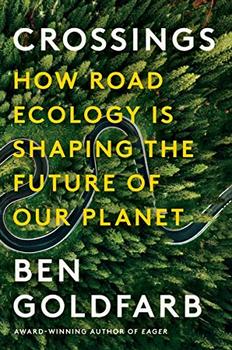Summary | Excerpt | Reviews | Beyond the Book | Readalikes | Genres & Themes | Author Bio

Critics' Opinion:
Readers' Opinion:
First Published:
Sep 2023, 384 pages
Paperback:
Sep 10, 2024, 384 pages
 Book Reviewed by:
Book Reviewed by:
Rose Rankin
Buy This Book
Introduction
The Wing of the Swallow
If you've ever driven across the United States of America, you have passed beneath the wings of a plucky songbird—smaller than your palm, light as your pocket change, feathered in jaunty blue and umber—called the cliff swallow. Where other animals flee the human footprint, cliff swallows shelter in its tread. Petrochelidon pyrrhonota should properly be called the bridge swallow, for our steel spans have furnished it with more nesting sites than bluffs and canyons ever did. Once a bird of the western mountains, in the last century cliff swallows have spread onto the Great Plains and across them, plastering their gourd-shaped mud nests to girders and trusses, feats of avian engineering no less impressive than our own viaducts.
"Once the environment is ruined," a biologist named Charles Brown told me, "all we'll have left is rats, cockroaches, and cliff swallows."
Cliff swallows are gregarious birds whose colonies can number in the thousands. Like most civilizations, theirs are messy: they steal nests, bully others into mating, fight so viciously that they sometimes tumble into rivers and drown. For the last four decades Brown has paid annual visits to more than two hundred nesting sites in Nebraska, trying to figure out what makes swallow societies thrive or fail. He has studied how well they catch insects, how they spread diseases, how they fend off snakes. He has captured more than four hundred thousand swallows in nets and encircled more than two hundred thousand slender legs with coded metal bracelets. Mostly what he has done is drive, more miles than he can hazard, from bridge to bridge, colony to colony. "Ninety-eight percent of cliff swallows in western Nebraska," Brown said, "are going to be within fifty feet of a road."
Near a road, of course, is the most dangerous place an animal can live, and swallows, for all their agility, occasionally fall victim to passing cars and trucks. When Brown and his longtime collaborator, the ornithologist Mary Bomberger Brown, began studying swallows in the 1980s, they picked up these casualties, wings broken and heads crushed, and brought them to their lab. They dressed the bodies—replacing eyes and viscera with cotton, lacing up feathered breasts like shoes—and tucked them in a drawer. They didn't have any plan for the birds; it just seemed proper. The waste of death diminished by the salvage of data.
Years passed. The number of publications mounted; the swallows flourished. In 2012 a new assistant asked Brown to teach him the art of dressing birds. Brown promised there would be plenty of roadkill on which to practice. When summer arrived, though, there was virtually no roadkill to be found—just empty asphalt and swallows, gloriously alive, taunting the vehicles below.
The epiphany hit Brown like an eighteen-wheeler: this was not a single-summer fluke. Swallow roadkill had been dwindling for years. He'd collected twenty dead birds in 1984, when the project began, and twenty more in 1985 and 1986. Then the trend line slanted downward, straight as a ski slope: fifteen in 1989, thirteen in 1991, eight in 2002. By 2011 the toll had dropped to four.
Brown considered various explanations, then dismissed them. There weren't fewer swallows to be whacked or more vultures bearing away carcasses, nor was there less traveling on his part. No, Brown thought: somehow swallows had become harder to kill.
He found his answer in the corpses themselves. When he stretched a tape measure from the birds' shoulders to their outermost feathers, he found that car-struck swallows had longer wings than the average bird he snared in his nets. The difference was slight, no more than a few millimeters, but the gap had unmistakably grown over the years. Brown immediately understood the significance. Long wings were good for straight, lengthy flights: between nests and feeding grounds, for example. Shorter wings were better for maneuverability, for performing the tight pivots and rolls with which a swallow would evade a falcon—or a flatbed hauling a load of lumber to Omaha. Traffic was weeding clumsier, long-winged swallows from the population and favoring their nimbler, short-winged flockmates. It was Darwinian selection in action, so clean and rapid it belonged in a textbook.
Excerpted from Crossings by Ben Goldfarb . Copyright © 2023 by Ben Goldfarb . Excerpted by permission of W.W. Norton & Company. All rights reserved. No part of this excerpt may be reproduced or reprinted without permission in writing from the publisher.




What really knocks me out is a book that, when you're all done reading, you wish the author that wrote it was a ...
Click Here to find out who said this, as well as discovering other famous literary quotes!
Your guide toexceptional books
BookBrowse seeks out and recommends the best in contemporary fiction and nonfiction—books that not only engage and entertain but also deepen our understanding of ourselves and the world around us.